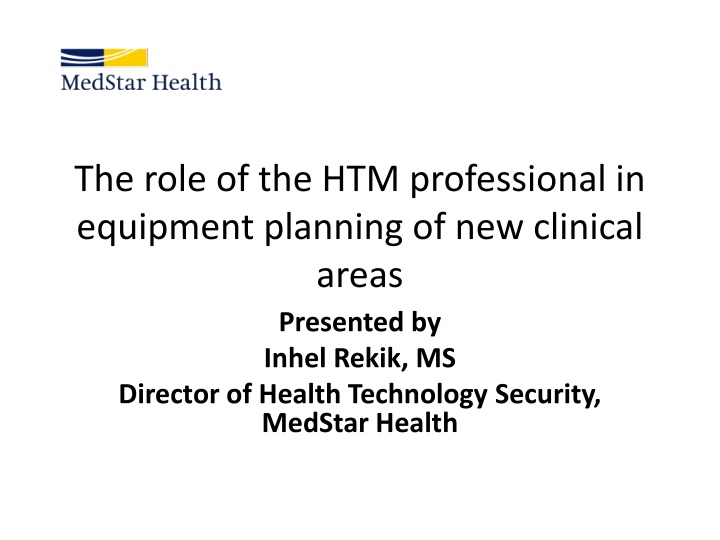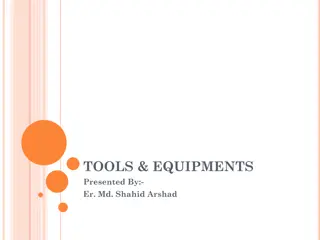Equipment Planning in Clinical Areas: Vital Considerations and Collaborations
Inhel Rekik, MS, from MedStar Health, sheds light on the crucial role of HTM professionals in equipment planning for new clinical spaces. Key aspects covered include collaborating with equipment planning consulting firms, IT, and facilities, along with a compelling case study on Hybrid OR. Learn about important planning considerations, working with equipment planning companies, IT integration, and facility engagement.
Download Presentation

Please find below an Image/Link to download the presentation.
The content on the website is provided AS IS for your information and personal use only. It may not be sold, licensed, or shared on other websites without obtaining consent from the author.If you encounter any issues during the download, it is possible that the publisher has removed the file from their server.
You are allowed to download the files provided on this website for personal or commercial use, subject to the condition that they are used lawfully. All files are the property of their respective owners.
The content on the website is provided AS IS for your information and personal use only. It may not be sold, licensed, or shared on other websites without obtaining consent from the author.
E N D
Presentation Transcript
The role of the HTM professional in equipment planning of new clinical areas Presented by Inhel Rekik, MS Director of Health Technology Security, MedStar Health
Plan of the presentation Important aspects of equipment planning How to work with equipment planning consulting firms How to work with IT How to work with facilities Case study: Hybrid OR Lessons learned
To be the trusted leader in caring for people and advancing health 1999 MedStar Health is established as the new name for the largest not-for- profit health care system in the mid- Atlantic region 30,000 associates and 6,000 affiliated physicians 10 hospitals MedStar Health care for more than half-million patients each year across Maryland and the Washington, D.C., region in our hospitals, urgent care and ambulatory care facilities, and physician offices MedStar Family Choice health plan
Important aspects of equipment planning What are the most important aspects of equipment planning? Identify the procedures that will be accomplished in the clinical areas Identify a planning team (surgeons, anesthesiologists, nurses, engineers (CE/Biomed), architects, facilities and IT) Establish responsibilities Perform as many site visits as possible Plan for (the ability of) future expansion
How to work with equipment planning companies Identify responsibilities Set expectations Be present in all meetings and discussions Verify equipment list Identify existing equipment in your inventory Recommend technology Make sure they plan for future expansion
How to work with IT Have them engaged from the beginning of the project Work with them to identify IT needs for the project Plan for BMDI
How to work with facilities Understand the involvement of facilities in the project Provide them with power and data requirements Cabling diagram
Case study Hybrid OR
Hybrid OR Why build a hybrid OR suite? Perform open heart surgery, complex vascular surgery and minimally invasive cardiac surgery in one location Endovascular procedures are becoming more complex and require the back up of an OR Accommodate emergency cardiac procedures
Equipment planning for a Hybrid OR Identify the procedures that will be performed in the OR Create a mock up room to determine what works and what doesn t work Imagine workflow and determine where the equipment will be positioned in the room (invasive to non invasive) Determine where the equipment will be parked in the room (storage room) Obtain a drawing that shows the positioning of all equipment in the room Determine which equipment can be shared
Control Room Space and layout are important :Which one is a better design and why?
Equipment Selection Establish criteria for selection of equipment and evaluation forms with the staff Options needed Angiography unit: (need to be selected early in the process) Ceiling mounted system or floor mounted Monoplane versus Biplane Low dose while providing a clear image (tissue dose reporting and fluoro times) Size of the detector For Adult hybrid OR, a robotic system is usually selected because it s fully robotic and can be parked away.
Equipment Selection Operating table Interoperability with radiology system Angiography table or a robotic surgery table Peds hybrid utilize a regular OR table
Equipment Selection Hemodynamic system (What s the most important selection criteria?) Standardize
Equipment Selection Monitors Large screen monitor (up to 24 inputs) No monitors on the wall but we ran conduit to the wall where viewing monitors or cameras could be mounted for future needs A 46 inch monitor in the control room for the residents and other staff to view the procedure from the control room
Equipment Selection Booms: Perfusion boom and nursing booms similar Verify the range of the boom, movement and reach 3 D simulation and Mock up room Location gas outlets (suction on top of flowmeters won t work) Cabling Surgical Robot: An integration kit for the room was purchased allowing the Surgical Robot cart to be connected to the equipment boom. You will need to determine where surgeons consoles will be located and to which boom the Surgical Robot will connect to for proper room integration/placement
Equipment Selection Surgical lights As few ceiling mounted OR lights as possible to prevent collisions with the booms and other equipment; need to be positioned to cover the entire table 2 OR lights to host an in light camera and 4 ceiling mounted lights Headlight: Battery operated headlights to gain space in the operating field
Equipment Selection Integration system Size of your router in the room (number of inputs and outputs) Get a list of all the medical devices that you will be displaying in the room. Sending images to the surgical Robot PTZ camera has two video feeds: one to the integration system and one to a dedicated monitor for Cathlab (not enough outputs in the router) Location of the video plates based on the location of the equipment Determine the options needed: use a questionnaire Control medical equipment ESU, OR lights , Endoscopic tower Recording and archiving Videoconferencing
Equipment Selection Important to make sure all the systems purchased integrate with each other Hemodynamic system in peds hybrid didn t integrate with our anesthesia (MDDS)
Equipment Selection If you purchase a new device or interface an existing device with information system, testing need to be done in advance.
Equipment Selection Lasers Shields: In addition to the shields placed on the boom on each side of the table, ensure that sufficient shielding is available for entire staff (procedures and more stringent regulations regarding protecting staff due to radiation safety) Intercom Contrast injector
Equipment Selection Ultrasound Dedicated 3D echocardiography ICE (shared between OR and Cathlab) IVUS shared between Hybrid ORs Supplies: Location to hang the lead Apron worn by the staff
Design Elements That Facilitate Shifting From Non Invasive to Invasive No shelves: to avoid collisions with other equipment in the room and make the room more flexible Equipment on wheels Storage on wheels, no built in cabinets Dedicated room for storage of equipment not used all the time Determine where the equipment will be parked in the room when not in use: Surgical Robot tower, Endoscopic Tower, Contrast Injector, etc . Space for perfusion to enter the room
Lessons Learned Determine the staff that will use the room Cathlab tech to operate the hemodynamic system Trained X ray tech to operate angiography system during the entire case Create a strong procedural program Dedicated staff and super users The multidisciplinary team needs to learn to work together and learn each others work flow Collaboration between Cathlab and OR is key
Lessons Learned Ensure rooms will be utilized to their full potential : (ROI) Identify case load needs prior to project start Ensure all requested options are needed and will be utilized If only a C arm is needed then it is not cost effective to install an advanced radiography system Make the positioning of the room work for different disciplines (trauma vascular, Emergency cases)
Other lessons Learned It s important that all parties with interest be involved and participate in all meetings and walkthroughs Identify where the equipment will be positioned in the room to plan for appropriate data and power Plan enough room for the equipment room: Determine ahead of time the IT needs of the project and have IT involved from the beginning of the project If you hire a consultant to do the planning, be very involved in all aspects of the project Plan for future expansion and compatibility























